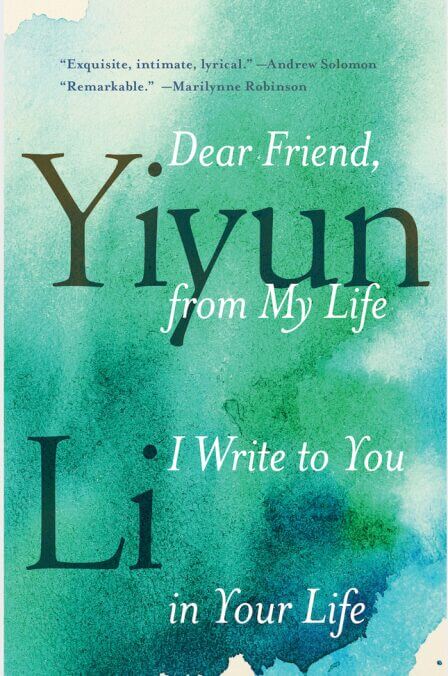

A paradox lies at the center of any memoir about suicide, the fact that one can’t write about the desire to kill oneself while that desire overwhelms. The buried tenet of the memoir is made explicit in such work: the past has been filtered through the necessarily changed circumstances of the present. “Our memories tell more about now than then,” Yiyun Li writes in the opening pages of Dear Friend, from My Life I Write to You in Your Life. “Doubtless the past is real. There is no shortage of evidence… But we choose and discard from an abundance of evidence what suits us at the moment.”
Li foregrounds her own selectivity: she is open about her indirect approach, honest about the skirted truths to come. “All people lie,” she says, “in their writing as much as in their life.” Dear Friend is a memoir-in-essays composed of equal parts writing and life. Li considers the works and biographies of authors she admires—Katherine Mansfield, John McGahern, William Trevor, Elizabeth Bowen—alongside scenes from her own biography: her childhood and adolescence in Beijing, her scientific studies in Iowa, her travels as a writer, and two periods of time spent hospitalized as a stay against suicide.
The problem of memoir and suicide bothers Li less as a writer than as a reader: she turns to the words of others for conversation and guidance. “I wish that they would teach one how to die,” she writes. “But their deaths can only be read in edited versions. Their letters and journals come to an end, artfully and artificially maneuvered by the editors.” Even without that maneuvering, no discovery is guaranteed: letters and journals might be less artfully arranged without containing any more truth. Li knows this; she admits to her own omissions. “I had been keeping a journal,” she writes of the time shortly before one hospitalization. “If my mind was losing control, I wanted it to be a process that could be understood by words, but I did not record this moment in Amsterdam.” The moment was one in which she envisioned herself unconscious on the airport floor, and was comforted by the sight—though she elides it from her journal, the memory persists.
Questions of what we secret away—both from others and ourselves—run through Dear Friend; its title (taken from Mansfield’s notebooks) gestures at the vast gap that conversation attempts to span. “What a long way it is from one life to another,” Li says, “yet why write if not for that distance, if things can be let go, every before replaced by an after.” As memory after memory makes clear, there is much that cannot be let go. The past is no longer present, its emissaries inevitably edited by time and need, and yet it remains, irreplaceable. “One writes about what haunts one,” says Li.

The ghosts that haunt Li are slippery and often obscured. “These essays were started with mixed feelings and contradictory motives,” she writes. “I wanted to argue against suicide as much as for it, which is to say I wanted to keep the option of suicide and I wanted it to be forever taken away from me.” To say of a memoir that it is about suicide lends itself to certain expectations for the book’s content: the grisly preoccupation, the tortured reasoning, the methodical walk-through of preparations for the act. But none of this appears in Dear Friend; Li is not interested in revealing those particular moments. “[I]n writing and in life,” she says, “one is often sustained by memories unshared.”
Instead, suicide serves as a black hole at the book’s core, bending the light around it. Li’s writing is oblique without sacrificing clarity, philosophical without sacrificing elegance. She doesn’t duck the question but renders, in impeccable prose, the impossibility of answering. In excavating a brilliant mind, Dear Friend gestures to the mind’s very vastness, to how much more can not—or will not—be contained by words. The tendency, in so many blurbs and reviews, is to praise memoirs as brutally honest, searing, unflinching—but Li flinches, beautifully. She admits contradiction; she admits to picking and choosing, to unknowing, to withholding. “Everything I say is scrutinized by myself, not only the words and their logic but also my motives,” she writes. “As a body suffers from an autoimmune disease, my mind targets every feeling and thought it creates.” In the book’s afterword, she mentions the addenda that dot Michel de Montaigne’s 16th-century essays—each paragraph accompanied by an A, B, or C—in order to clarify that passages were written at different times. Montaigne’s editor tells the reader that the essays “are intended to be a record of change.”
The essays in Dear Friend were also written across long months and different moods, though they appear seamless and suddenly made, like objects forged or hewn. Li’s lines tend toward aphorism: “Is writing not my way of rehearsing death?” she asks; she says: “To say we know a person is to write that person off.” In an essay about McGahern’s memoir, Li writes of how the work reopened wounds, “laying them bare (yet not raw).” Bare (yet not raw) is a succinct glossing of Li’s own style: direct in its indirectness, a neat circumscription of pain. The tendency is to call this kind of writing unemotional as if that were a compliment, but I think Li would reject it: emotions are exactly her concern. Her work reminds me that the popular adulations of memoir—honest, brave—are merely guesses: only the writer knows how much courage or truth a work has required. And they are, at any rate, beside the point. I would take precision over porousness any day.
-

-

-

-

-

-

-

-

-

-

-

-

-

-

-

-

-

-

-

-

-

-

-

-

-

-

-

-

-

-

-

-

-

-

-

-

-

-

-

-









































